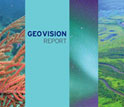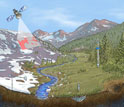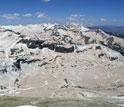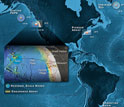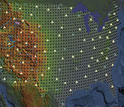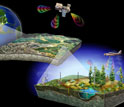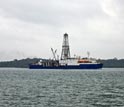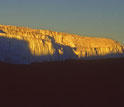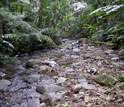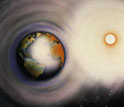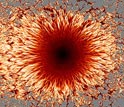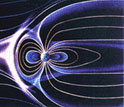News Release 09-238
From Outer Space to Inner Earth: NSF-supported Presentations at American Geophysical Union Conference Present New Discoveries
Water in Earth's critical zone; declining water resources in the U.S. west; "zebra stripes" in rock; dark energy under the sea-floor; undersea volcanic eruptions; Sumatra earthquake zone among topics

NSF National Center for Earth-surface Dynamics scientists study rock "zebra stripes."
December 11, 2009
This material is available primarily for archival purposes. Telephone numbers or other contact information may be out of date; please see current contact information at media contacts.
Society stands at a crossroads. With growing problems such as resource depletion, energy sustainability, environmental degradation and climate change, can we protect the health of the planet while achieving widespread economic prosperity?
This and other questions will be addressed at the fall meeting of the American Geophysical Union (AGU) in San Francisco, Calif., Dec. 14-18.
Below are selected AGU presentations from among thousands that feature National Science Foundation (NSF)-supported research. All times are Pacific Standard Time (PST).
MONDAY, DECEMBER 14
NSF Directorate for Geosciences Community Meeting
7:30 p.m., San Francisco Marriott Marquis, Room Pacific H
Tim Killeen, NSF assistant director for geosciences, and George Davis of the University of Arizona, chair of NSF's Advisory Committee for Geosciences (AC-GEO), will discuss the recently released NSF AC-GEO report GEO Vision: Unraveling Earth's Complexities through the Geosciences and geosciences directions for the future. NSF geosciences management staff and program directors will also talk about opportunities in existing programs.
"Earth is a dynamic marvel of complexity and beauty," says Killeen. "We as geoscientists must work to meet the challenge of understanding its many facets, and use that knowledge to advance our stewardship of its systems. The AC-GEO's report could not be more timely."
The challenges ahead for the geosciences, the advisory committee found, are understanding and forecasting the behavior of a complex and evolving Earth; reducing vulnerability and sustaining life; and growing the geosciences workforce of the future.
"It is essential going forward that we have the scientific tools and evidence to understand and anticipate how the Earth will be transformed in the future, and at what rate, in response to these growing pressures," says Davis.
"To identify these influences and their potential impacts requires an understanding of Earth, its history, and its systems grounded in basic science--a science that probes and ultimately defines Earth's character."
Scientists and engineers will be called upon in the future to supply the insights and predictive capabilities required to inform key policy decisions, many with long-lasting effects.
"Leading many of those discussions will be geoscientists," states the report, "who will share their understanding of the Earth system with the public and with decision-makers, providing the scientific knowledge that will ultimately guide society as it comes to understand its evolving relationship with the planet."
Earthquakes at the Edge: Observing and Understanding Processes Along Subduction Zones
8:00 a.m., Moscone Center West, Sessions T11D, T12A, T13E, T14A
(and Tuesday December 15, Moscone Center South, 8:00 a.m., Sessions T21C, T23B)
On December 26, 2004, the Indian Ocean tsunami focused the world's attention on a topic that scientists have been studying for years--the devastation unleashed by subduction zone earthquakes.
Thirty-two talks and seventy posters will provide a global perspective on the properties that control earthquake and tsunami generation. Results circle the Pacific Ocean "Ring of Fire" and explore earthquake danger in the Caribbean and the Mediterranean regions. The 2004 and subsequent events in Sumatra have provided an unprecedented view of earthquakes. New frontiers in the understanding of subduction zone earthquakes have been opened by related research: ocean bottom seismometers record earthquakes close to their source, capturing movement previously missed by onland studies.
Harold Tobin of the University of Wisconsin and colleagues will report on results from Integrated Ocean Drilling Program (IODP) research off Japan that reaches close to the source of the earthquakes. The Nankai Trough Seismogenic Zone Experiment (NanTroSEIZE) has advanced to 1,600 meters below the sea-floor in its plan to drill 7,000 meters under the seabed. There scientists will place long-term monitoring instruments into the main plate boundary fault zone.
Water Loss in the Upper Colorado River Basin: Desert Dust Deposited on Mountain Snowpack a Culprit
1:40 p.m., Moscone Center South, Poster Hall, Session U13B-0052
(Related presentations also on Tuesday, December 15, 1:55 p.m., Moscone Center West, Room 3014, Session C22A-02; Wednesday, December 16, 1:40 p.m. Poster Sessions C33B-0500, C33B-0501)
Snowmelt in mountains in the U.S. West is happening at an accelerated rate, a result of desert dust blowing onto peaks in the Rockies and other locations.
Current dust levels on mountains are five times greater than they were before the mid-19th century, due in large part to increased human activity in deserts; on average desert dust has led to the earlier disappearance of mountain snow cover by at least a month. However, in 2009, 12 desert dust storms painted the Colorado mountain snowpack red and caused snow cover retreat nearly two months earlier than usual.
Earlier snowmelt caused by deposition of desert dust, says scientist Thomas Painter of the University of Utah, depletes natural water reservoirs formed by mountain snowpacks, and affects the delivery of water to urban and agricultural areas. Painter's research is funded by NSF's Division of Atmospheric and Geospace Sciences. With climate change, warming and drying of the desert southwest are likely to result in even greater dust accumulation in mountains. This has broad implications, says Painter, for land and water management in the western U.S. and in other regions such as Central Asia's desert-mountain ecosystems.
TUESDAY, DECEMBER 15
Buried Alive: The Deep, Dark Biosphere of "The Intraterrestrials"
8:00 a.m., Moscone Center West Room 3016, Sessions B21D, B22A; 1:40 p.m., Poster Hall Session B23C
The intraterrestrials, they're called, and they live in the land of dark energy.
They're microbes found deep beneath the ocean floor.
"Who in his wildest dreams could have imagined that, beneath the crust of our Earth, there could exist a real ocean ... a sea that has given shelter to species unknown?" So wrote Jules Verne in A Journey to the Center of the Earth. Indeed, as Verne suspected, life exists under the sea-bed, although perhaps not quite at the center of the Earth.
Scientist Katrina Edwards of the University of Southern California and numerous colleagues affiliated with NSF's Dark Energy Biosphere Institute, a Research Coordination Network, will report on the latest findings on intraterrestrials in three back-to-back sessions on the deep biosphere. Among subjects to be addressed are: subsurface microbial observatories deployed in newly formed ocean crust; bacteria from deep-sea sediments at the Loihi Seamount; viral infections as controlling factors for the deep biosphere; how continuous metabolic activity is maintained in the deep biosphere; and new estimates of total microbial subseafloor biomass.
Using the National Ecological Observatory Network (NEON) to Measure Vegetation Adaptation to Environmental Change
1:40 p.m., Poster Hall, Moscone South, Session B23A-0352
The National Ecological Observatory Network (NEON) is a national-scale research platform for documenting and analyzing the impacts of climate change, land-use change, and invasive species. NEON features sensor networks and experiments linked by cyberinfrastructure to record and archive ecological data. The network partitions the U.S. into 20 ecoclimatic domains. Each domain hosts one fully instrumented core site in a wildland area, and two re-locatable sites.
Vegetation monitoring will enable the study of environmental changes over different time scales. The resulting data will improve our understanding of vegetation responses to environmental change and lead to better models of the effects of climate change, according to Patrick Martin of the NEON office in Boulder, Colo. Martin will present information on vegetation, environmental changes, and NEON.
An Analysis of NSF Geosciences 2009 Research Experiences for Undergraduates (REU) Site Programs
2:10 p.m., Moscone Center West Room 3020, Session ED23B-03
The NSF Research Experiences for Undergraduate (REU) Program provides undergraduate students with opportunities to conduct research at other institutions than their home universities, and in areas that may not be available at their home campuses.
NSF Directorate for Geosciences program officers Lina Patino, Lisa Rom and Susan Weiler, along with researcher Sara Sanchez of the University of Arizona, will discuss results of a survey on REU recruitment methods, student demographics, enrichment activities, and fields of research. The survey was sent to the principal investigators of each of 50 active REU Sites; more than 70 percent of the surveys were returned. The results are being used to examine strengths in REU sites, find opportunities that may be underutilized, and identify community needs for enhancing this NSF-wide program.
Integrated Ocean Drilling Program (IODP) Town Hall Meeting
5:30 p.m., The W San Francisco Hotel
IODP scientists will present updates on program activities--expeditions, highlights of 2009 projects, and recent international meetings--and discuss the future of IODP. A Q&A session with panelists who are IODP scientists, program leaders and funding representatives will follow a welcome reception and program discussion.
Space Physics and Aeronomy Section Town Hall Meeting
6:15 p.m., Moscone Center West, Room 2003
The Space Physics and Aeronomy (SPA) town hall meeting will provide an opportunity to hear from NSF, NASA, and other agency officials. Representatives will provide information on current and future activities, programs, and opportunities, with highlights of recent milestones and successes. In response to a solicitation for questions from the AGU SPA membership, the representatives will be asked to address questions.
WEDNESDAY, DECEMBER 16
Water in the Critical Zone: Major Elements, Trace Elements and Isotopes as Biogeochemical Tracers
8:00 a.m., Moscone Center West Room 3007, Session H31I; 1:40 p.m., Poster Hall, Session H33H
Global Soil Change: New Frontiers for the Biogeosciences
4:00 p.m., Moscone Center West Room 3016, Session B34B (Thursday, December 17, 8:00 a.m., Poster Hall, Session B41B)
(Friday, December 18, 8:00 a.m., Moscone Center West Room 2008, Sessions EP51E, EP52B; 1:40 p.m., Poster Hall, Sessions EP53C, EP53D)
How do landscapes evolve over both human generational time scales and multi-millennia, and how is this process affected by the presence and flow of water? How do soil and weathered bedrock move down hillslopes, and how are they coupled to the evolution of the channel that usually surrounds the base of the hillslopes? How do biological processes impact physical processes? Are there signals in the landscape that can tell us about past climates, and about how landscapes have responded--and might in the future--to climate change?
NSF's three Critical Zone Observatories (CZOs), in watersheds in the Sierra Nevada, the Front Range of the Colorado Rockies, and the Appalachian Uplands, are investigating Earth surface processes and how they are affected by fresh water.
Three CZO sessions will bring together researchers who are working on the interactions among chemical, physical, and biological processes in Earth's critical zone. This zone is the region between the top of the forest canopy and the base of unweathered rock: our living environment. The session on water in the critical zone will focus on use of tracers to understand water flow paths and biogeochemical reactions. The tracers used range from naturally occurring isotopes of water to applied chemicals like sulfur, to solutes released by weathering processes. Other sessions explore interactions among geomorphic processes, chemical weathering, vegetation and hydrology, and carbon and nitrogen fluxes in soils, and the impacts of global change.
Climate-induced Changes in Streamflow at NSF's Hubbard Brook Experimental Forest Long-Term Ecological Research Site
1:40 p.m., Poster Hall, Session H33E
Long-term data from the Hubbard Brook Experimental Forest in New Hampshire, one of 26 NSF Long-Term Ecological Research (LTER) sites, show that air temperatures have increased by 1 to 1.5 degrees C over the past 50 years. Annual precipitation has also increased by 19 to 26 percent during the same time period. These changes in climate influence streamflow, which provides a climate signal that incorporates physical (snowpack, evaporation) and biological (evapotranspiration) responses.
Unlike the western U.S., in the U.S. northeast, water is generally abundant. However, changes in flow could affect stream ecosystem services in the region, such as drinking water, irrigation, recreation, wastewater assimilation and hydropower. Scientists at this LTER site analyzed long-term data to determine whether past changes in climate have affected the distribution and quantity of streamflow, and will present their results.
THURSDAY, DECEMBER 17
Submarine Volcanic Eruptions: Scientists Observe Active Deep-Ocean Volcanoes
1:40 p.m., Moscone Center West, Sessions V43I, 44B
Active--and spectacular--seafloor volcanic eruptions are the focus of this session. Scientists will discuss volcanic eruptions near seamounts, including submarine fountains and bubble-bursts; talk about the impact of volcanic eruptions on mid-ocean ridge biological communities; and present recent observations of seamounts and volcanoes using undersea vehicles like the Nereus hybrid remotely operated vehicle (HROV), a new type of deep-sea robotic vehicle that may be tethered or untethered to a mother ship.
Geologists believe that most volcanic eruptions on Earth occur in the deep ocean. Deep-sea volcanic eruptions are an important component in Earth and ocean heat budgets, and in oceanic cycles of iron, calcium, phosphorus and carbon dioxide.
"We've now been able to witness--up close--the way submarine volcanoes, and ultimately, ocean islands, are born," says Barbara Ransom, program director in NSF's Division of Ocean Sciences.
Zebra Stripes of the Atacama Desert: Evidence ofClimate Changes
4:45 p.m., Moscone Center West, Session EP 44A-04
Hillsides in the arid region of the Atacama Desert of northern Chile show distinct bands of dark gravels and light soils: "zebra stripes." Scientists affiliated with the National Center for Earth-surface Dynamics (NCED) at the University of Minnesota, an NSF Science and Technology Center, are working to discover how and when zebra stripes first formed.
Using Google Earth, satellite imagery and field observations, the scientists have made the first quantitative observations of zebra stripes. The stripes, they found, likely have existed for millennia. The pattern has been preserved thanks to the prolonged aridity of the Atacama. In the stripes are clues to profound climate changes that occurred between the late Pliocene and early Pleistocene. New information on zebra stripe formation may help researchers interpret surface rocks in other arid regions on Earth, says H. Richard Lane, program director in NSF's Division of Earth Sciences, and perhaps on other planets.
Disturbance on Alaska's North Slope: Effects of a Large Wildfire on Ecosystem Carbon and Nitrogen Dynamics
5:45 p.m., Moscone South 103, Session U44A
One of the predictions of climate warming is an increase in the size, intensity and frequency of wildfires, particularly in the Arctic. For three months in late summer 2007, the Anaktuvuk River fire raged across 386 square miles of Arctic tundra on the North Slope of the Brooks Range, Alaska, tripling the area burned there since 1950.
Michelle Mack of the University of Florida and colleagues sampled tundra soils in this area and found that the fire sent more than 4.8 billion pounds of carbon and more than 1.3 million pounds of nitrogen into the atmosphere. Using radiocarbon dating they estimate that the fire consumed 37 years of accumulated soil carbon. Mack proposes that in the most severe sites, representative of about 47 percent of the burned area, soil carbon will probably not recover to pre-fire levels over the next millennia, during which time the tundra is likely to burn again. If carbon stocks do not recover before the next fire, then tundra burning could be a strong, positive feedback to atmospheric carbon dioxide levels and climate warming in the Arctic. Mack's work is funded by NSF's Division of Environmental Biology and Office of Polar Programs.
Ocean Observatories Update: OOI, MARS, NEPTUNE Canada, and VENUS6:15 p.m., Moscone Center West, Room 2006
Ocean scientists will present updates on the progress, current status and upcoming activities of the Ocean Observatories Initiative (OOI), the Monterey Accelerated Research System (MARS), the Victoria Experimental Network Under the Sea (VENUS), and the North-East Pacific Time-Series Undersea Networked Experiments (NEPTUNE) Canada programs. All four programs have made moved forward this past year, including the installation of science nodes and instrument platforms on NEPTUNE Canada, plans for expanding the capabilities of VENUS, the successful deployment of experiments on MARS, and the start of the construction phase of the OOI network.
EarthScope Research Opportunities in the Gulf of Mexico Region
6:15 p.m., Moscone Center West, Room 2008
The Gulf of Mexico and adjacent coastal plain present scientific challenges to understanding past and present patterns and rates of subsidence, and their tectonic, magmatic, and ancient and modern sedimentological evolution, geologists say. These challenges involve the basin's rift history, coastal and deep water processes, and hydrocarbon resources. In the next two years NSF's EarthScope program will target the Gulf Coast region. This direction provides an opportunity to develop cross-disciplinary studies that will advance scientists' understanding of Gulf of Mexico geology and natural resource utilization. This town hall meeting is focused on discussion of research in these areas.
The Role of NSF's Environmental Observatories in Ecology and Earth Systems Science
7:30 p.m., Moscone Center West, Room 2002
The nation needs a long-term, comprehensive strategy to collect and analyze data on the impacts of large-scale environmental changes on oceanic, atmospheric and terrestrial systems, scientists believe. To facilitate decision support at the federal, state, local and tribal levels, these data must be turned into credible forecasts and information products that are easily accessible to resource managers. This town hall meeting brings together leaders from emerging environmental observatories to discuss how the nation's climate change mitigation and adaptation needs may be met through the collective efforts of federal and nonfederal entities. Tim Killeen, NSF Assistant Director for Geosciences, will present opening remarks.
EarthScope Town Hall Meeting
7:30 p.m., Moscone Center West, Room 2003
Geologists will present an update on NSF's EarthScope program and discuss the EarthScope Science Plan.
Greg Anderson, NSF EarthScope Program Director, will talk about current EarthScope status, including facility enhancements made possible by ARRA funding as well as highlights of the science program, and will discuss long-term plans for EarthScope. The EarthScope Steering Committee will lead a discussion of a months-long effort to update the EarthScope Science Plan, a draft of which will be released for comment by December 12, 2009. This is the guiding document for EarthScope over the next 5 to 10 years.
Antarctic Scientific Drilling Town Hall Meeting
7:30 p.m., Moscone Center West, Room 2009
The importance of understanding the long-term response of the Southern Hemisphere cryosphere-ocean-atmosphere system to climate change requires high-quality paleorecords provided by sediment cores recovered from around Antarctica. Because of long planning horizons and intense logistical requirements for conducting scientific drilling in this remote region, strategic coordination of activities is required. This town hall meeting will offer time for discussions of IODP, ANDRILL (ANtarctic geological DRILLing) and related initiatives, and opportunities for scientific community involvement in developing an integrated Antarctic scientific drilling plan.
FRIDAY, DECEMBER 18
Processes in the Critical Zone: Interaction of Rock, Water and Life
Please see Wednesday, December 16, 8:00 a.m. critical zone co-listing.
Cobble-Boulder River and Stream Channel Beds: Implications for Salmon Over-wintering Habitat
5:00 p.m., Moscone Center West, Session EP54A-05
River and stream channel beds dominated by cobble- and boulder-sized particles provide over-wintering habitat for steelhead trout and other salmon. The fish use these spaces as refuge from high water flow, especially where large woody debris and off-channel habitat are not present.
Methods for predicting the occurrence and quality of cobble-boulder substrate are needed to guide population modeling and land use management to support salmon restoration efforts. Scientists affiliated with the National Center for Earth-surface Dynamics (NCED) at the University of Minnesota, an NSF Science and Technology Center, will report results of an ongoing study of the controls on cobble-boulder occurrence in Pescadero Creek, a forested coastal watershed in central California. Their goal is to develop and test a predictive model of cobble-boulder occurrence that can be applied to other watersheds where availability of overwintering habitat may be a limiting factor for salmon populations.
-NSF-
-
NSF's Advisory Committee for Geosciences released a report in October: GEO Vision.
Credit and Larger Version -
Scientists at NSF's Critical Zone Observatories research watersheds across the country.
Credit and Larger Version -
Desert dust tinges snow red in Colorado mountains, affecting water supplies.
Credit and Larger Version -
"Dark energy" is found in ocean depths: life abounds above and beneath the seafloor.
Credit and Larger Version -
The locations of NSF's Ocean Observatories Initiative sites are shown in this graphic.
Credit and Larger Version -
NSF EarthScope geologists have installed seismic stations across the continent.
Credit and Larger Version -
The National Ecological Observatory Network is among NSF's environmental observatories.
Credit and Larger Version -
Drillship JOIDES Resolution has led to the success of the Integrated Ocean Drilling Program.
Credit and Larger Version -
Ice fields atop Tanzania's Mount Kilimanjaro glow golden, melting in a warming climate.
Credit and Larger Version -
Scientists from NSF LTER sites like Luquillo in Puerto Rico will talk about stream and river flow.
Credit and Larger Version -
Newly discovered interactions between the Sun and the Earth affect our climate.
Credit and Larger Version -
The interface between a sunspot's central and outer regions: a complex structure.
Credit and Larger Version -
An artist's rendering shows the solar wind as it streaks by Earth.
Credit and Larger Version
Media Contacts
Cheryl Dybas, NSF, (703) 292-7734, email: cdybas@nsf.gov
Related Websites
NSF AC-GEO GEO Vision Report: http://www.nsf.gov/geo/acgeo/geovision/start.jsp
NSF Directorate for Geosciences: http://www.nsf.gov/dir/index.jsp?org=GEO
NSF Ocean Observatories Initiative: http://www.oceanleadership.org/ocean_observing
NSF EarthScope Program: http://www.earthscope.org
Integrated Ocean Drilling Program: http://www.iodp.org
NSF Long-Term Ecological Research Network: http://www.lternet.edu
NSF National Ecological Observatory Network: http://www.neoninc.org
NSF National Center for Earth-surface Dynamics: http://www.nced.umn.edu
NSF Dark Energy Biosphere Institute: http://darkenergybiosphere.org
The U.S. National Science Foundation propels the nation forward by advancing fundamental research in all fields of science and engineering. NSF supports research and people by providing facilities, instruments and funding to support their ingenuity and sustain the U.S. as a global leader in research and innovation. With a fiscal year 2023 budget of $9.5 billion, NSF funds reach all 50 states through grants to nearly 2,000 colleges, universities and institutions. Each year, NSF receives more than 40,000 competitive proposals and makes about 11,000 new awards. Those awards include support for cooperative research with industry, Arctic and Antarctic research and operations, and U.S. participation in international scientific efforts.
Connect with us online
NSF website: nsf.gov
NSF News: nsf.gov/news
For News Media: nsf.gov/news/newsroom
Statistics: nsf.gov/statistics/
Awards database: nsf.gov/awardsearch/
Follow us on social
Twitter: twitter.com/NSF
Facebook: facebook.com/US.NSF
Instagram: instagram.com/nsfgov



